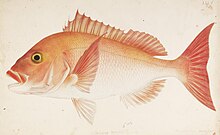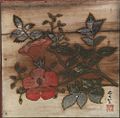|
Kawahara Keiga  Kawahara Keiga (Japanese: 川原慶賀, also known as Taguchi Takumi or Toyosuke, Nagasaki, 1786–1860?) was a late Edo period Japanese painter of plants, fishes, birds, reptiles, crustaceans, social scenes, landscapes and portraits at the Dutch Factory of Dejima, and at Edo, Kyoto and Nagasaki.[1] His works can be found in museums in Japan (about a hundred works) and in the Netherlands (about a thousand), among others. CareerKawahara was born in Nagasaki as the son of the painter Kawahara Kozan. He studied with the painter Yūshi Ishizaki (1768–1846). With special permission from the Japanese government, Kawahara worked as a painter at the Dutch factory of Dejima, Nagasaki, from 1811 to 1842. At the request of successive directors at Dejima, Kawahara documented many aspects of life of Japan in general and at Dejima in particular. From 1823 to 1829, Kawahara drew and coloured detailed images of Japanese flora and fauna, at the behest of Dejima commander, physician and botanist Philipp Franz von Siebold. In 1825 Carl Hubert de Villeneuve (1800–1874) came to Dejima and taught Kawahara the fundamentals of Western painting techniques. As a result, Keiga introduced Western techniques in traditional Japanese painting. In 1826 he accompanied Von Siebold together with Heinrich Bürger during his visit to the court at Edo, and documented many objects, street and court scenes. In 1829, he was imprisoned by the Tokugawa shogunate for involvement in a spying incident of Siebold, who was subsequently expelled from Japan. In 1842, Kawahara was punished again, now for depicting the harbor of Nagasaki with family crests showing and therefore was dismissed from Nagasaki. In 1846 he put his signature on five ceiling paintings in the main hall of the Buddhist temple Wakimisaki Kannon (now in Wakimisakimachi, Nagasaki-shi, Nagasaki). Kawahara's images have been fundamental for biological publications by Coenraad Jacob Temminck and Hermann Schlegel.[2][3] TechniquesKawahara used watercolor-coloured pencil drawing on paper for his biological work. For other works he also painted on silk and wood, like his paintings on the ceilings of several temples in Japan. Gallery of Kawahara's work
Museum collections with his workFor instance
See alsoSourcesWikimedia Commons has media related to Kawahara Keiga. Other external links and literature
References
|







